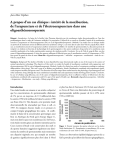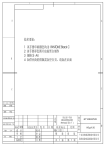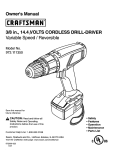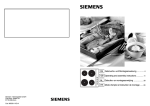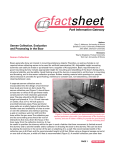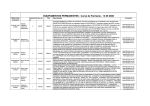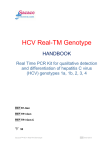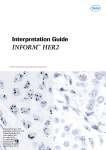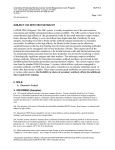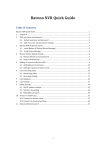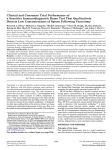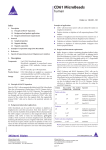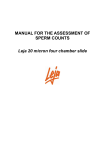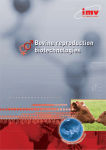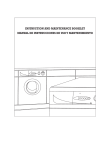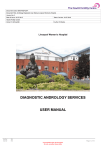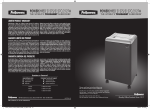Download MATERIAL FOR SPERM ANALYSIS - Automatic Diagnostic Systems
Transcript
MATERIAL FOR SPERM ANALYSIS Laboratory equipment: Plastic Gloves Recommended without Talcum Slides Recommended: Leja 10 (human), leja 20 (animal). Or Makler chamber. Temperature control: keep the chamber to the 37ºC using a heating stage or inside the incubator Use a micropipette with a particular volume of sample(different for each analysis chamber, see instructions of use). With the Makler chamber you have to capture the fields images and videos outside the grid and avoid line of scratching. Neubauer counting chamber (only for manual counting) Sample sterile collection container (e.g. Sarstedt: 100 mL) www.automaticdiagnosticsystems.com 1 Phase contrast microscope (10x Ph +for human, Ph- for animals, 40X, 100x phase contrast positive objectives) . Microscope slides (standard size); Coverslips (18 x 18 mm, # 1½ [thickness]; 22 x 22 mm; # 1½) Automatic Pipettes for making wet preparation: Air displacement (positive displacement recommended): 6 µL morphology smears: air displacement (positive displacement recommended): 8-15 µL vitality smears: air displacement (positive displacement recommended): 15-50 µL www.automaticdiagnosticsystems.com 2 Pipette tips: Plastic, for air displacement pipettes, volume 5-50 µL Air pipettes www.automaticdiagnosticsystems.com 3 Centrifuge (1000-3000g) Test tubes for ICSI preparation, centrifugation, etc. Incubator (with humidity and CO2 control) or heated chamber (+37°C) Medium for sperm washing/sample cleaning. www.automaticdiagnosticsystems.com 4 HOW TO PERFORME THE ANALYSIS: Basic Guide lines for human semen analysis: - Abstinence days: W.H.O. recommended a period is between 2-7 days. Collection: In sterile container maintained at 20-37ºC (important to avoid rapid temperature changes) and stored in an incubator at 37ºC protected from light. The sample must be analyzed between 30 and 60 minutes from the collection time. 60 minutes maximum. TIMING OF PERFORMING ANALYSIS: 0-5 minutes: collect all the sample details and put the container in the incubator at 37ºC. 0-30 minutes: Check the liquefaction of the sample, the presence of prostatic crystals, and all the macroscopic parameters (In case of ICSI, put 1 ml of sample in a test tube and overlayed it with 1 ml of swim-up solution and wait 30 minutes). Perform the motility and vitality analysis and prepare the stained slide for the morphology analysis. After 30 minutes: Analyze the morphology slide (has to be dry and the sperms has to be dead and fixed). MATERIAL FOR MOTILITY ANALYSIS: - Microscope: 10x positive phase contrast objective (Ph negative for animals). Disposables/Materials: Leja slides 4 chambers, 10 microns or Makler chamber (or Newbauer). Automatic pipettes and pipettes’ tips. 1. Procedure with Makler (Subjective analysis) REMEMBER TO HEAT THE MAKLER AT 37ºC BEFORE USING IT (10 MINUTES IN THE INCUBATOR OR ON HEATING STAGE). 1) Homogenize the sample moving gently the container. 2) Take 5 µl of sample and put it in the center of the makler chamber (in the center of the circle) then cover with the cover round slide of the chamber pressing gently to homogenize the volume of sample on the surface (must have no air bubbles in the chamber). 3) With a 20x-40x objective count the spermatozoa in ten squares (random or on the diagonal). www.automaticdiagnosticsystems.com 5 Organize the counting in: - motile progressive sperms - motile no progressive sperms - motile in situ sperms - static sperms The total number of counted sperms represents the total concentration (to obtain the total concentration multiply by 1x10^6). To obtain the percentage of the four categories of sperms divide the total number for the number of each category and multiply by 100. Æ Total number of sperms X 100= % of rapid progressive sperms Nº rapid progressive Æ Total number of sperms x 100= % of motile no progressive sperms Nº motile no progressive Æ Total number of sperms x 100= % of motile in situ sperms Nº motile in situ Æ Total number of sperms x 100= % of static sperms Nº static sperms . If the number of sperms is very low, count the sperms in all the grid and then divide the number obtained for 10. Æ Total sperm number counted in all makler x 10^6= total sperm concentration 10 Attention: count only the head of the sperms inside the squares and the heads on square’s sides chosen before by the user. two of the Fig.1 www.automaticdiagnosticsystems.com 6 “Pin heads” should be counted separately and commented in the report form. Immature germ cells should not be counted (these will be assessed in differential morphology count), but round cells and inflammatory cells should be counted in the same way as the sperms and their number added in the final report. ”Borderline cases": only spermatozoa whose head is located on the upper or left limiting lines (marked “OK” in Fig. 1) should be counted as ”belonging” to that square. Thus, do not count spermatozoa located on the lower or right limiting lines (marked “out” in Fig. 1). Æ Clear the Makler chamber with tap water and dry very well (if the Makler chamber is very damaged and scratched, must be changed with a new one). 2. PROCEDURE WITH LEJA SLIDE (Automatic Analysis) Before performing the analysis, leave the Leja slide 10 minutes in the incubator at 37ºC or on the heating stage. Using the positive displacement micropipette, pick up 1 µl of semen and release slowly the sample in the right space of the Leja slide waiting until is filled by capillarity. Put the specimen slide in the microscope, focus and analyze with the SCA motility & Concentration module. (Leja 10 is for 4 analysis; one analysis for each chamber in the slide). IMPORTANT: In case of high concentration in the sample (> 90 millions/ml) the W.H.O recommends to dilute the sample in order to better analyze the concentration and motility. After the counting remember to arrange the values to the dilution (if you are working with SCA you just have to insert the dilution rate in the window that will appear on the screen before the analysis). SPERM SAMPLE DILUITIONS: Table 1: Dilution of the ejaculate Spermatozoa per field of vision 40X objective Dilution Semen µL Diluent µL < 15 1 + 4 (1:5) 100 400 15-40 1 + 9 (1:10) 50 450 40-200 1 + 19 (1:20) 50 950 1+ 49 (1:50) 50 2450 Quality Control www.automaticdiagnosticsystems.com 7 Duplicate counting should be done to detect random errors in sampling and counting chamber. Calibration of the positive displacement pipettes (some times called PCR pipette) and ordinary pipettes for measurements of diluents should be done regularly. Pipettes showing erroneous results should be amended according to instructions of the manufacturer or sent for repair and adjustments. Results of calibration controls as well as repairs and adjustments should be recorded in a separate list for each pipette. Great care is needed when mixing and diluting semen, mixing the diluted sample and preparing counting chambers (attachment of coverslip). Counting chambers should be checked for accuracy when new and regularly after use (risk for wear and changed chamber depth). Values for semen Variables: Normospermia: Normal ejaculate values. Oligospermia: Sperm concentration < 20 Mil/ml Asthenospermia: Forward progression (type A-B) sperms concentration < 50% or <25% rapid progressive (type A) spermsconcentration. Teratozoospermia: Percentage of normal morphology <30%. Oligoasthenoteratozoospermia: Signifies disturbance of all three variables, < concentration + < progressive sperms + < normal morphology. Azoospermia: No spermatozoa in the ejaculate. Aspermia: No ejaculate. www.automaticdiagnosticsystems.com 8 SPERM WASHING Sperm washing is the process that prepares a semen sample for an intrauterine insemination (IUI). For an IUI to be performed, the semen sample must be washed free of debris, white blood cells, and prostaglandins, which can cause the uterus to contract. The processing also removes dead sperm and concentrates the sperm into a small volume that can easily be handled by the uterus. There are three main methods of sperm washing: the swim-up, density gradient wash, and simple (centrifugation) wash. The type of wash used depends on the individual characteristics of each semen specimen. Swim-Up Method The swim-up is most successful when performed on patients with a normal semen analysis and is not recommended for samples of high viscosity, with high numbers of round cells, or with a high content of debris.In this procedure, the washing media is gently placed over the semen in a conical tube.The specimen is then placed in an incubator for approximately one hour.During this time, the sperm are allowed to swim up into the media, with the purpose of collecting the most motile, normal sperm, free of debris.The supernatant is collected and centrifuged twice with sperm washing media.The final pellet is then resuspended in approximately 0.5 mls of media.Modified sperm washing media must be used to process the sample. Density Gradient Wash Method The discontinuous (density) gradient method should be used on samples containing round cells or debris, or those with increased viscosity but a relatively normal concentration and motility.The gradient is achieved by layering media of two different densities in a conical tube.The semen is then placed on top of the gradient and the tube is then spun to allow the specimen to proceed through the gradient.The resulting pellet should contain the motile, normal sperm, while the dead sperm and debris are caught up in the gradient media.The pellet is then resuspended in washing media and centrifuged twice.The final pellet is resuspended in a final volume of approximately 0.5 mls of media.There are several commercially available kits. Simple Wash Method The simple (centrifuge) sperm wash should be performed on a sample that has a decreased concentration and/or motility.A sample containing round cells and debris should not be prepared by this method.Sperm washing media is added to the specimen and centrifuged.The pellet is recovered, resuspended, and centrifuged again.The final pellet is resuspended in approximately 0.5 mls of media. In each of the above cases, the laboratory performs an analysis on both the fresh specimen and washed specimen.This will include an assessment of the count, motility, volume, and viscosity. www.automaticdiagnosticsystems.com 9 WHEN THE SAMPLE IS VERY DIRTY YOU HAVE TO CLEAN IT IN ORDER TO PERFORME A GOOD ANALYSIS. The recommended medium is Pure Sperm: 1) One uses a 40% solution on top and a 80% solution at the bottom in a centrifuge tube. 2) Then put 2ml of sperm on top and centrifuge at x600 for 20 minutes. 3) At bottom a pellet with beautifully clean sperm and 100% motility. www.automaticdiagnosticsystems.com 10 VITALITY ANALYSIS: STAINING FOR VITALITY TEST: Duo vital (to work with the SCA Vitality module under fluorescence): DUO-VITAL KIT FOR SPERM VITALITY ASSESMENT IN ANIMAL SPECIES The assessment of sperm vitality is one of the basic elements of semen analysis. Vital stains can help to differentiate live from dead sperm. Results of vitality test are linked to the integrity of the plasma membrane of viable sperm; an intact plasma membrane is able to exclude certain stains either for bright-field microscopy or fluorescence microscopy. Sperm vitality evaluated with the combined use of fluorescent dyes correlates with that determined by eosin-nigrosin stains (bright-field microscopy) but opens a new range of possibilities for automatic counting using flow citometry or fluorescence microscopy and image analysis data collection. The DUO-VITAL kit is for the evaluation of sperm vitality from fresh or unthaws semen samples. The kit provides the user with specific adjusted solutions of two reagents to evaluate sperm vitality by means of a dual emission fluorescent signal (Green: Live; Red: dead). Protocol: Step 1: Dilute the sperm sample to a final concentration of approximately 10-15M/ml Step 2: Add 1 microliter of the diluted sperm sample onto a clean slide. Add 1 microliter of the fluorochrome solution red, and 1 microliter of the fluorochrome solution green to the diluted sperm sample and mix. Cover with a clean coverslip and observe under the fluorescence microscope. Score “green” as live cells and “red” as dead cells. The analysis is automatic with the CASA Sperm Class Analyzer-SCA Vitality. In some cases, “green-red” fluorescent sperm nuclei are observed. This is mainly due to an incipient loss of membrane integrity. Score this sperm nuclei as “dead”. Used under these conditions, DUO-VITAL provides a High Effective Fluorescent Signal for confident visual analysis of sperm vitality. The combination of DUO-VITAL with Computer Assisted Sperm Analysis -CASA/Leja (or alternatives) multiple chamber slides allows the simultaneous assessment of sperm concentration, vitality and motility. A CASA system for such purposes is available (SCA-Vital. Microptic SL, Barcelona, Spain. www.automaticdiagnosticsystems.com 11 2.Eosine (To analyze with SCA Video counter): Reagents Eosine Y Æ Prepare the staining solution mixing a 0.5% (5g/l) solution of Eosin Y (C.I. 45380) in a 0.9% (9 g/l) aqueous sodium chloride solution. Procedure: 1) Mix one drop (10-15 µl) of fresh semen with the same volume of Eosin solution on a microscope slide and cover with a coverslip. 2) After 1 minute observe the preparation with 20x or 40x objective under bright light or phase contrast. 3) Count unstained sperm (white) as alive, and the stained sperm (rose) as dead. 3. Eosin–nigrosin (To analyze with SCA Video Counter) Reagents: Eosin Y (C.I. 45380), 10 g/l, in distilled water, i.e., 1% Nigrosin (C.I. 50420), 100 g/l, in distilled water, i.e., 10% Procedure: - Mix one drop of semen with two drops of 1% Eosin Y. - After 30 seconds, add three drops of 10% nigrosin solution and mix. - Place a drop of the semen–eosin–nigrosin mixture on a slide and make a smear within 30 seconds of adding the nigrosin. The smears should not be too thick. Allow to air-dry and examine under oil immersion (1000) with a light microscope. The live spermatozoa are white and the dead are stained red. The nigrosin provides a dark background which makes the slides easier to assess. www.automaticdiagnosticsystems.com 12 MORPHOLOGY ANALYSIS: Microscope: 100x oil objective Materials: Diff-Quik staining solution (3 bottles, protocol). or Cell-Vu prestained slide for morphology (protocol). or Sperm Blue staining solution. Positive displacement Micropipette 1. DIFF-QUIK Diff-Quik fixative Solution, Diff-Quik Solution 1 (red), Diff-Quik Solution 2 (blue). Distilled water STEP-BY-STEP DESCRIPTION: If the raw sample is less than 1 M/ml, you can concentrate according to the following procedure: 1. Determine the concentration of the sample (C). 2. Transfer 500 µl of sample to a centrifuge tube and add 1000 - 2000 µl of washing medium (e.g.Hams F10 + 1% BSA). 3. Mix gently by swirling or agitate by running tube once along the top of an empty test tube rack (no vortex). 4. Centrifuge sample for 5 minutes at 200 g. 5. Carefully aspirate the supernatant - being extremely careful. The volume of the remaining pellet should be approximately 10 µl . 6. Resuspend the pellet using the volume determined by the following equation: ..........................V= 5C µl Thus, if a sample had an initial concentration (C) of 20 M/ml, then: ........................ V= (5)(20) = 100 µl So 100 µl of washing medium would be used to resuspend the pellet. Samples that are concentrated using the above procedure may not have to be washed. However, if the smear shows excessive debris, additional washing will be necessary. Washing the sample If the sample shows a lot of detritus is convenient to wash it: 1. Place 500 µl of sample into a microcentrifuge or conical tube. www.automaticdiagnosticsystems.com 13 2 Add 500 µl of washing 2. g medium (H Hams F10 + 1% BSA). If Percoll is used, the specimen must m be wash hed complete ely Percoll-fre ee before staining, otherwise sta aining will be e incomplete. 3 Swirl or Repeat 3. R pipettte gently to mix. m 4 Centrifuge for 5 minuttes at 200 g. 4. 5 Remove supernatant by aspiration 5. n. 6 Resuspend pellet in 500 6. 5 µl of wasshing medium m. 7 Repeat pipette 7. p gentlyy to mix. 8 Centrifuge a second time 8. t for 3 minutes at 500 0 g. 9 Remove supernatant by aspiration 9. n. 10. Resuspend pellet with h 125 µl of washing w medium. 11. Repeat pipette p gentlyy to mix. The sample is no ow ready to use u to make a smear. If sam mple is extremely debris laden, repea at steps 8-11 again Prepare at least two smears s from each sample s as fo ollows: e-cleaned microscope slid des with alco ohol. Rinse with w distilled water and wipe w 1. Wash pre dry. Warm m slides on the slide warmer set to 37 7°C. 2 Place a 5 µl droplet of sperm nearr the frosted end of the microscope 2. m slide. 3 Using ano 3. other slide held obliquelyy to the first (approximate ( ely 30° angle e), touch it ag gainst the drop of o sample (a away from the e frosted end d). 4 After the droplet has spread 4. s along g the junction n of the slide e, gently pull the second slide s away from m the drop along the leng gth of the firs st slide. Note: If specimen hass a very low initial concen ntration (10 M/ml M or less)), the droplett should be e spread in a streak down n the center of the slide to t conserve ssufficient spe erm density. Place ed prepared smear on the e slide warm mer and allow w to air dry (a approximatelyy 15 minutes s). mmendable) Staining with Diff--Quik (recom www w.automaticd diagnosticsyystems.com m 14 Reagents & Supplies Needed • • • • Diff-Quik Kit: consisting of Fixative, Stain Solution #1 and Stain Solution #2 Distilled Water Coplin Staining Jars Paper towels Diff-Quik Staining Protocol 1. 2. 3. 4. 5. Fix smear by immersing slide in Diff-Quik Fixative 1 second 4 times Stain sperm by immersing fixed slide in Diff-Quik Solution #1. 1 second 4 times Stain sperm by immersing slide in Diff-Quik Solution #2. 1 second 4 times Rinse slide gently in distilled water. Allow to dry If re-examination of slides is required, coverslipping will help prevent deterioration of the smear due to repeated exposure to immersion oil. It will also help to maintain a clean objective. Though coverslipping is optional, it is recommended. Mounting a coverslip onto the slide requires the use of a mounting medium such as the Eukitt mounting medium. Coverslipping Procedure 1. Place 3-4 drops of mounting medium along the center of the dried slide. 2. Carefully place a clean coverslip (50mm x 22mm) on the slide. 3. Press the coverslip gently to distribute the mounting medium. 4. Allow to dry sufficiently. www.automaticdiagnosticsystems.com 15 Advises for morphology analysis with Sperm Class Analyzer: The following images show different kind of captures: 1. Correct image: - Clean background Light stain Optimum illumination control Separated spermatozoa 2. Incorrect image: - Two spermatozoa heads very close together. 3. Incorrect image: www.automaticdiagnosticsystems.com 16 - Background with a lof of detritus. Dirty background Incorrect image: - Too light image (some of the midpices cannot be analysed) www.automaticdiagnosticsystems.com 17 Incorrect image: - Too dark field (not enough contrast) Incorrect image: - Too stained (acrosome cannot be detected) www.automaticdiagnosticsystems.com 18 Incorrect image: - One spermatozoon´s head is very close together with the tail of another. www.automaticdiagnosticsystems.com 19 2.Cell-VU® Prestained Morphology Slides Direction for use: 1. Apply a small drop (approximately ~2-4 microliters) of specimen on the center of the slide. 2. Place a longer coverglass (24 x 60 mm) on top of the slide, exerting slight pressure on the coverglass. Note: Do not slide the coverglass as this will remove the stain. Note: You can place covered slide coverglass side down on paper towel and press gently. 3. Allow slide to stand at room temperature for 15 minutes before microscopic observation is made. (Place loaded slide on heating plate for 1 minute if you do not want to wait.) Expected Findings: These slides are for evaluating sperm head/acrosome size, differentiation of white blood cells in peripheral blood and cytology of body fluids. Notes: The stain absorbs into living or “recently” dead sperm. If the sperm were dead at the time of collection they would be in some state of degradation and no longer able to absorb the stain, but if you not prepared your slide immediately and the sperm has just died, it will still stain. You can archive for 30 days. Let air dry, remove coverglass and store in dark place. You will loose the tails, but should still be able to see the heads fine. If you need to reread, a drop of stain on the slide will “refresh” the slide. 3. Sperm Blue Staining Procedure Background: The stain has been developed to stain all the components of the sperm (acrosome, head, midpiece and main piece of tail) differentially in different intensities of blue. The staining procedure is extremely simple and only involves two main steps, fixing in one medium and staining in a second medium. It works equally well for smears of “raw” semen as well as swim-up/Percoll/Pure Sperm gradient preparations using most culture media. Contents of Sperm Blue: All Sperm Blue packages contain vials, bottles with equal volumes of fixative (Clear or transparent solution in buffered salt) and a dark blue stain (dark blue staining solution in buffered salt). Sperm Blue is packaged in three variations: www.automaticdiagnosticsystems.com 20 1. Small 1.8ml vials consisting of 50 vials containing fixative and 50 vials containing the stain. Allow fixing and staining of 200 smears on slides. (Approximately 0.45 ml sufficient to stain one slide). 2. Two bottles containing 100 ml each of fixative and 100 ml stain. Allow staining of 200 smears on glass slides. 3. Two bottles containing 250 ml each of fixative and 250 ml of stain. Sufficient to stain 500 sperm smears on slides. If fixative and stains are stored at 4C it will last for one year. Room temperature storage not guaranteed. Staining Procedure: 1. Make sperm smear using 5µl of semen or 5 to 10 µl of swim-up sperm (adapt volume to concentration of sperm) and allow to air dry. 2. Use a plastic disposable pipette to put 0.45 to 0.5ml of clear fixative solution over smear. Roll slide from side to side regularly to ensure proper fixation over smear surface. Fix for 10 minutes. 3. Wash by dipping slide gently 2 to 3 times in beaker containing distilled water. 4. Use a plastic pipette to put 0.45 to 0.5ml of blue stain on fixed sperm smear. Roll slide from side to side regularly and stain for 10 minutes. 5. Dip slides very gently 3 to 5 times in beaker containing distilled water until most of blue colour disappears on slide. Air dry. 6. Mount slide with DPX or equivalent synthetic medium for permanent slides. When mounting medium is dry view under oil immersion x1000. OR 7. Do not mount cover slip after air drying but put immersion oil directly on slide and study immediately using oil immersion optics at x1000. Discard slide after use (not permanent). Precautions: All cytological stains are toxic and handle with care. Always work with gloves and preferably in a fume cupboard (preferable but not essential for Sperm Blue). Only stain when sperm are fixed (dead). Do not use for live unfixed cells. www.automaticdiagnosticsystems.com 21 W.H.O SPERM MORPHOLOGY A. Head defects. (a)Brush (b)Pyriform (c) Round Without Acrosome (c) Amorphous (d) Vacuolated www.automaticdiagnosticsystems.com Small (e) Reduced Acrosome 22 B. Neck and Midpiece defects. (g) Bent neck (h)Asymmetrical insertion (i)Thick midpiece C. Tail defects. (K)Short/Cut (l)Thin midpiece D. Cytoplasmic droplet (l) Bent (m) Coiled www.automaticdiagnosticsystems.com 23 DNA FRAGMENTATION: Kit Halomax: Protocol included in the Halosperm kit for 10 analysis (see the attached file). Is always recommendable do swim up of the semen sample before any analysis motility, morphology, or DNA fragmentation analysis, to avoid the interference with the debris of the sample. Protocol for the ICSI semen preparation-cleaning: 1) Put all the volume of the sample in a test tube (conical bottom if the sample has an high concentration, otherwise normal test tubes) and add gently on the surface (maintaining the pipette attached to the internal side of the test tube, no drops directly) 6 ml of G-Sperm with an air pipette . Close the test tube. 2) Put the test tube in the centrifuge 1500 g/sec for 10 minutes (1400 g/sec if is the conical one) 3) When the centrifugation time is finished, take off all the upper liquid part leaving the bottom with the semen. 4) Add gently on the surface maintaining the pipette attached to the internal side of the test tube (no drops directly) 3 ml of G-Sperm and repeat the centrifugation: 1500 g/sec for 10 minutes (1400 g/sec if the test tube is the conical one). 5) When the centrifugation time is finished, take off all the upper liquid part leaving the bottom with the semen. 6) Swim-up: Add gently on the surface maintaining the pipette attached to the internal side of the test tube (no drops directly) 0.5 ml of G-sperm. 7)Leave the test tube close (but not completely, the stopper only above, not pressed on) in the incubator at 37ºC for 1 hour. 8)After 1 hour pick up from the surface (without touching the pellet below) 0.25 ml and put in a smaller test tube with the name of the patient and the concentration of the sample (this last one after the swim-up). Take a small aliquot from the main test tube and control the concentration. N.B. A normal Swim up made with a clean sample is prepared in a test tube putting on the bottom 1 ml of semen and then adding gently 1 ml of G-sperm on the surface (maintaining the pipette attached to the internal side of the test tube, no drops directly). www.automaticdiagnosticsystems.com 24 Put the sample in the incubator at 37ºC with the stopper not completely closed (it has to move. After 1 hour pick up 0.5 ml of liquid from the surface (the liquid has to be transparent and clean, don’t touch the semen below) and put it in a smaller test tube. Pick up a small aliquot and control the concentration of the swimming sperm. The meaning of the swim up is to provide a selection of the best motile spermatozoa. If is a preparation for an intrauterine insemination, the protocol is the same, just change the G-sperm with the sperm-washing. Gradients of density: Cleaning: put in a test tube Æ 1 ml of LOWER solution Æ 1 ml of UPPER solution Æ 2 ml the semen sample (if the volume is higher, use two Different test-tubes). Put the test tube in the centrifuge at 1500 g/sec for 10 minutes. Recuperate the pellet in the bottom of the test tube (through away the rest) and put it in a small test tube with 0.5 ml of sperm-washing solution. Mix gently with the pipette. Take a small aliquot of the final sample and count concentration (the count represent the final concentration/2 because the volume is 0.5 ml). www.automaticdiagnosticsystems.com 25

























